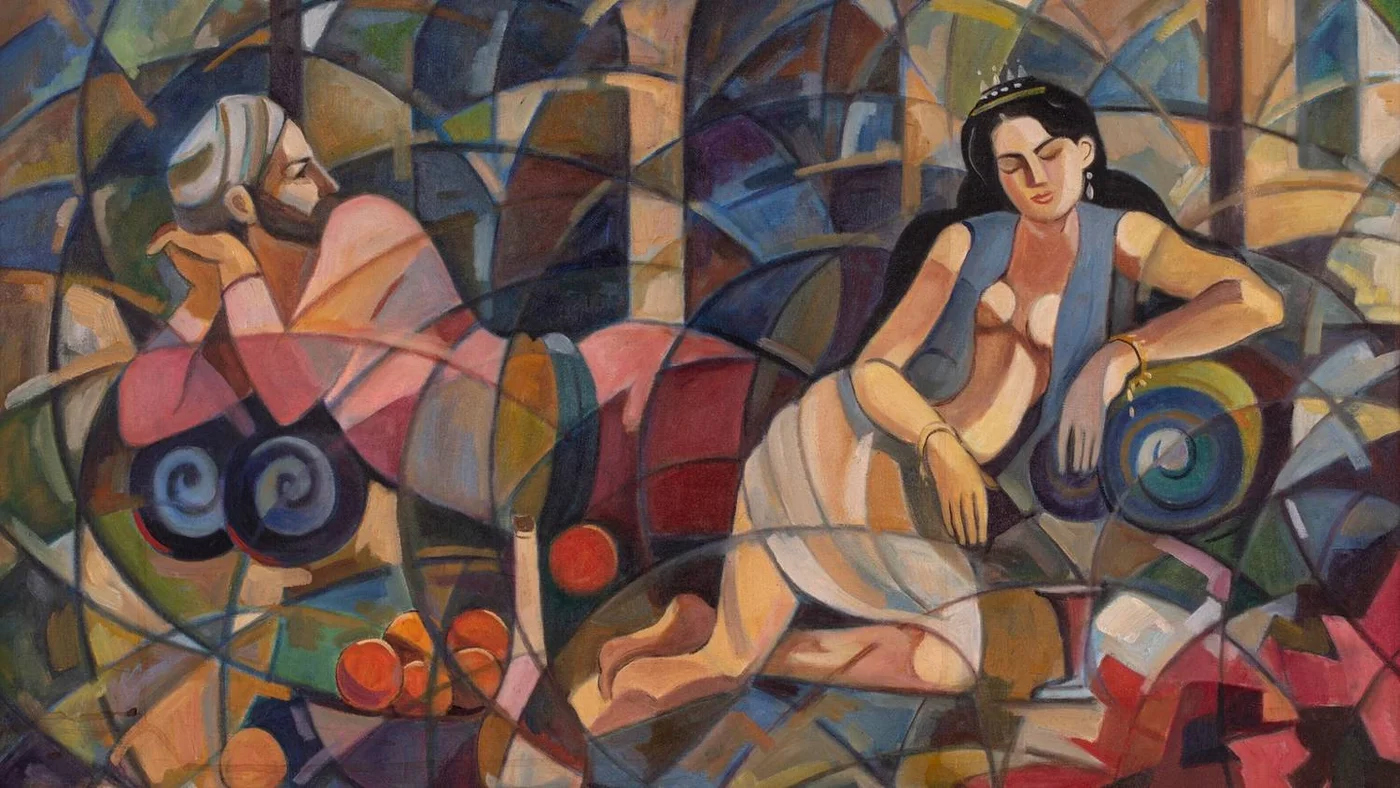“The Couple” (1976) by Iraqi artist Hafidh al-Droubi.
Narratives are powerful forces. When Syrians wake up after each conflict to proclaim or revive a narrative, they are, as Fadwa Abboud argues in her article "The War of Syrian Narratives" (published in Al Modon newspaper), "continuing their wars by other means." Abboud contends that Syrians are both victims and architects of the stories they tell about themselves. These narratives often evolve into tales of victimhood, shaping political and cultural growth through socialization. While not always grounded in strict facts, these stories weave into the collective imagination. In other words, what Syrians believe about one another may arise from imaginative constructs or distorted facts. Abboud asserts that these narratives lack authenticity and historical significance, especially when their stories were not permitted before December 8, 2024. She warns that they allow the past to invade the present, like a tumor in the political and intellectual body, ultimately poisoning the future.
Abboud highlights the impact of inauthentic narratives, raising questions about the truthfulness of such stories. She shares an anecdote about the 1982 Hama massacre, where the victims' relatives were denied the chance to receive condolences. In a society like Syria, this denial has profound consequences, depriving communities of emotional support and disrupting traditions that foster social cohesion. Additionally, Abboud describes how, after the 2011 revolution, the Syrian regime compelled families of detainees to sign false medical certificates stating that their sons, who had died from torture, had simply suffered heart attacks. Under pressure, these families buried their sons in silence and despair, simultaneously witnessing and misrepresenting their own tragedies.
Recent violent events in Syria’s coastal region have revived historical narratives. If Syrians had learned from history, they would have anticipated the emergence of narratives, counter-narratives, and denials. Abboud contends that the only difference from past massacres is the timing. However, she notes a critical shift since 2011: "Each side casts doubt on the other's injustices, minimizes them, or, in the worst case, views them as deserved punishment, even if it arrives late." Intellectuals engage in these debates, aligning themselves along tribal, sectarian, and ideological lines, particularly on social media. She states that "only those clutching a burning coal escape the entrenchment," referencing the difficulty of remaining impartial. A voice within her almost urges, "Take me!"
Abboud further observes, "Both sides began to revive their narratives, filled with blame, pain, and reproach. They recalled stories we believed had been forgotten, only to find them lying dormant beneath our beds." Numerous counter-narratives exist. Supporters of Assad dismiss the opposition's narrative, often mocking it. Similarly, supporters of the revolution minimize the injustices faced by former regime loyalists in the coastal region.
Inspired by Rwanda’s reconciliation process, Abboud considers whether this model could be applied to Syria. However, I wonder if she might be overly optimistic about such a comparison. She references Rwanda’s well-known three-level reconciliation approach, emphasizing the third level. The first level focused on justice and accountability, the second on healing and forgiveness, and the third — the most significant — on unity and development. This stage aimed to eliminate ethnic divisions and cultivate a shared national identity through policies like the "I am Rwandan" initiative. Economic growth, educational reforms, and community programs were crucial in rebuilding the country, ensuring long-term stability and social cohesion. Abboud highlights that the Rwandan model demands spiritual courage to transcend victimhood, rejecting that punishment alone can ease a victim’s pain or satisfy the desire for revenge.
Since the end of its civil war and the 1994 genocide against the Tutsi, Rwanda has experienced political stability, economic growth, and social reconstruction, despite ongoing concerns about political repression and human rights violations. Given this relatively peaceful period, Abboud highlights the lessons that Syria can learn. She opposes mocking opposing narratives and instead advocates deconstructing distorted perspectives that justify crimes as acts of ancient vengeance. No crime justifies another, she argues, and no injustice grants anyone the right to become an oppressor.
Unresolved conflicts weigh heavily on victims, turning their suffering into a means of robbing them of their humanity. According to Abboud, the critical steps toward reconciliation are acknowledgment and deconstruction — processes that shift pain into the museum of collective memory rather than letting it fester into cycles of retribution.
Supporters of the revolution face a moral dilemma. Many find themselves trapped in the victim narrative due to a long history of suppressed voices. However, as philosopher Paul Ricoeur suggests, "A wounded memory can be a pathway for reconciliation if the pain is met with recognition rather than competition over who the victim is." If pain remains unresolved or is endlessly recycled, it denies individuals the chance to move forward and risks being used as a pretext for further harm. Instead, these painful experiences must be transformed into inspiration, encouraging Syrians to listen to one another. Denial would squander a precious opportunity for humanity to prevail, allowing the monster within to take hold. As Abboud concludes, "The ghosts of the truths we bury today will return in the future to seek vengeance against us."
Fadwa Abboud’s essay, "The War of Syrian Narratives," was published in Arabic in Al Modon.
This article appeared in Inside Al Jadid Reports, No. 112, 2025.
Copyright © 2025 AL JADID MAGAZINE

